Robotics Education Journal
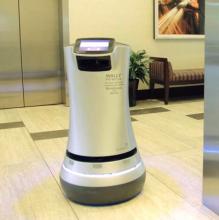 08/28/2017
08/28/2017 In a move destined to improve the quality of healthcare, Swisslog Healthcare, a major provider of medication and supply chain management solutions, announced an investment in Savioke, developer of the Relay autonomous mobile service robot. Relay provides “fast, secure delivery with a responsive, friendly human interface for more reliable and personalized patient services.”
 08/24/2017
08/24/2017 Tom Walker had an epiphany one day, a vision of how drones could be aggregated locally for search & rescue (SAR) purposes, to help authorities locate missing people. Walker built an application named “DroneUp” that once installed on your smartphone, allows law enforcement to notify nearby drone operators, who then make a quick decision to participate or not. DroneUp offers training to drone operators so that they can obtain commercial remote pilot certification from the FAA, which certification is required to participate as a DroneUp pilot.
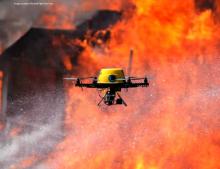 08/19/2017
08/19/2017 The Commercial UAV Expo Americas will take place at the Westgate Resort in Las Vegas, October 24 – 26, 2017. All major market segments will be addressed in industrial robotics, including Surveying & Mapping; Civil Infrastructure; Process, Power & Utilities; Aggregates & Mining; Construction; Law Enforcement; Emergency Response & Search and Rescue (SAR); and Precision Agriculture. Over 100 exhibitors have registered as we go to press. The second of these conferences, the Commercial UAV Expo held in 2016, had 1,720 attendees from every state in the U.S., and from 46 countries worldwide. This is a rapidly growing market, and a free report assessing its growth is being given away by The Commercial UAV Expo.
 08/11/2017
08/11/2017 Skylift is a pioneering company developing multirotor vehicles that can perform heavy lift services. Skylift’s website explains: “The global market for logistics surpassed $4 trillion in 2015. The goods we use each day are part of a complex global supply chain. The most critical part of this supply chain is the 'last mile,' comprising roughly one-quarter of the cost of everything we consume. The largest growth in logistics has come from on-demand direct delivery …over $300 billion has been earmarked for helicopter procurements over the next decade. [Until now,] no vehicle has been able to meet the primary requirements of these rising market demands.“
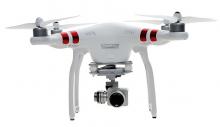 08/09/2017
08/09/2017 DJI quadcopters and hexcopters, sold globally, have been a dominant industry brand for years. Although the first to massively penetrate the worldwide drone market, DJI products have recently been banned by the Army and NAVY. It is known that Chinese manufacturers can embed spyware in every fold of such equipment, which can then be used to remotely surveil or disable the gear. Such spyware can be hidden in the most unlikely places, including battery cells and in parts of the devices that apparently are not electronically active.
 08/03/2017
08/03/2017 SPAR 3D.com, a leading source on 3D technology from sensing to 3D processing and visualization tools, reported that The Charles Stark Draper Laboratory, Inc., (Draper) plans to bring to market a price-leading lidar chip that will not only be used on self-driving automobiles, but in a variety of other applications, as well. It is possible that this ultra-micro lidar could end up as a feature on cell phones.
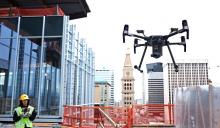 08/02/2017
08/02/2017 Constructiondive.com reported that Berkeley, CA-based 3D Robotics (3DR) and China-based, global drone maker DJI have partnered to launch a new drone operations platform that makes 3DR’s Site Scan surveying technology compatible with DJI drones. The Tuesday announcement by 3DR noted that DJI drones will now be able use the Site Scan Field mobile app.
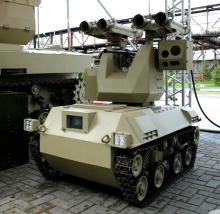 07/29/2017
07/29/2017 In late August Russian company Kalashnikov, famous for the AK47 combat rifle, will reveal a mobile, weaponized robot that ostensibly will be run by a neural network. While exact details are unknown, the general concept edges close to what has been considered a taboo zone—weaponizing a lethal robot without human oversight that can take decisions to kill human adversaries in a combat environment.
 07/27/2017
07/27/2017 Tom Simonite of Wired.com has posted a fascinating article on an imminent technological upgrade in robotics manufacturing that will both boost efficiency and eliminate untold numbers of jobs for human workers. In the next wave of warehouse automation, robots will handle products much as humans do today—they will pick, place and box products of all types.
Amazon currently operates 45,000 robots that move palates of boxed products through its large warehouses as product arrives, is sorted, stocked, sold and then picked for shipment to customers. Next generation robots will use arms with dexterous grippers that substitute for human hands. When this global army of robots is equipped with the ability to pick and place objects with adroit robotic hands, Amazon will become far less reliant on human workers.
Finding the best gripper technology for handling objects of different types (e.g., towels vs. hair brushes) is a complex challenge.
 07/25/2017
07/25/2017 For about two decades, now, U.S. scientists have been directly involved in Mars exploration through their robot proxies roaming or orbiting the red planet. This impressive work has been complicated by the extreme distances involved and the physical positioning of Mars and Earth with respect to each other and the Sun. About every two years, a phenomenon called “solar conjunction” places a several-day moratorium on communications with the robots roaming or orbiting Mars. This happens when Mars and Earth are on opposite sides of the blazing star around which we orbit. The phenomenon lasts several days and this year will span July 22 to August 1, 2017. To make the best use of time when we are out of contact with our Martian robots, NASA and its partners send a long list of commands to the Martian robots, including, for example, the Opportunity Rover. These commands may entail continued travel, as well as collection of meteorological data for later transmission back to Earth.
 07/17/2017
07/17/2017 In recent years, Walt Perko created a robotics education program for kids, the RoboGuts STEAM (Science, Technology, Engineering, Art & Math) program. Starting with a new, low-cost RoboGuts circuit board, it is an entry level system that targets youngsters in the 5 to 10-year-old range. Kids not only learn about electronic components, structured programing, but also how to build a working robot from the parts they print on a 3D printer.
Walt has been teaching beginner robot classes since 2011, and 3D CAD for beginners since 2012, and brings that experience to this offering. RoboGuts includes a custom designed beginner µController circuit board that is compatible with a wide range of microprocessors used in robotics education.
 07/15/2017
07/15/2017 New Enterprise Associates (NEA), a large Silicon Valley venture capital firm, sees the future and it’s in freight load hauling. Bernadette Tansey reported on Xconomy IT that NEA played a leading role in a $42m Series C financing round announced by Transfix, which was directed at a traditional industry not necessarily seen as a likely candidate for disruptive investment in artificial intelligence (AI). Robotics is coming to the interstate highway system on board semi-tractor trailer hauling rigs, and it’s much more than GPS.
 07/13/2017
07/13/2017 Think Tech Hawaii, hosted by Ted Ralston, offers particularly good online video programming covering all things drones and UAS. His show, Where the Drone Leads, is particularly relevant, today. In this recent show on the use of drones to facilitate public safety, Ted interviews George Purdy, of Drone Services Hawaii, UAS Lanai.
 07/10/2017
07/10/2017 The new educational table-top ‘Jet’ robot kits from NVIDIA, shipping from ServoCity, are among the most advanced such kits we have seen, and appear to mark a watershed moment in educational robotics. Two versions are available, based either on the Jetson TX1 or TK1 board, to better match your budget. Utilizing the ROS operating system, they come with new, sophisticated graphics processing units (GPUs) that are blindingly fast and that support powerful onboard CPUs to provide these robots with remarkable deep learning AI capabilities.
Moreover, the new kits are fully supported by curricula, forums and a variety of resources for educators ranging from webinars to resource libraries. The robotics teaching kit covers introductory and advanced topics including ROS, sensors, computer vision, machine learning, dead reckoning, path planning and more.
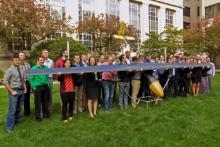 07/09/2017
07/09/2017 An MIT student team has designed and tested a disaster response drone with the ability to stay aloft for 5 days. This is a solution for challenging situations in which the normal communications infrastructure is disabled, which often happens in disaster scenarios. This under-150 pound, 24-foot wingspan UAV is designed to bolster telecommunications systems in disaster scenarios. But it’s not yet a perfect solution and is being modified to meet FAA requirements.
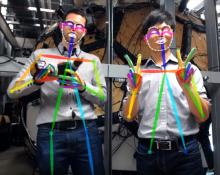 07/06/2017
07/06/2017 Byron Spice of Carnegie Mellon University (CMU) reported that CMU researchers have enabled a computer to understand body poses and movements of multiple people, and this includes resolving the positions of limbs and even fingers of hands in various poses and while grasping and using objects. The technology was developed using a Panoptic Studio, which is a dome embedded with 500 video cameras, but the resultant CMU-developed software can run on a laptop.
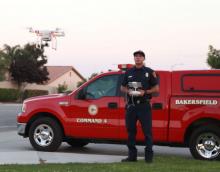 07/05/2017
07/05/2017 According to The Bakersfield Californian, the Bakersfield Fire Department has a new drone named LOIS, short for Low Orbiting Incident Satellite. This July 4th, the drone assisted the fire department in “sniffing out” illegal fireworks set off in prohibited areas. Crews patrolling the city were pointed directly to the scofflaws, who were given citations for $1,000 in the city, and $1,500 in unincorporated Kern county.
 07/04/2017
07/04/2017 Technology Training Corporation (TTC) has announced another of its highly respected symposiums. As reported by David Place, it will be a valuable opportunity for learning about the latest developments in the UAS / drone industry, and for networking. The Unmanned Aircraft Systems West Symposium will be held August 29 and 30 in San Diego.
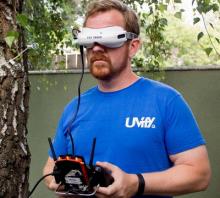 06/29/2017
06/29/2017 Fat Shark says a new standard has been set with its new digital drone goggles. Known for its consumer-grade analog goggles, Fat Shark has introduced a Base HD all-digital goggle set at a retail price of $350. The goggles offer a liquid crystal 720p display that Fat Shark suggests will mark an advance in goggle display brightness, clarity and contrast.
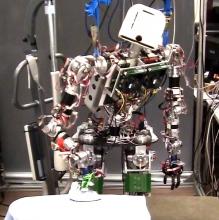 06/28/2017
06/28/2017 The BBC reported on a humanoid robot named Teo that has been developed at Madrid’s Charles III University. Teo is shown ironing clothes, albeit very slowly, and according to its lead developer, Professor Juan g. Victores, the goal is to eventually make it capable of performing any of myriad common household tasks typically carried out by humans.
 06/19/2017
06/19/2017 Frank Tobe of TheRobotReport.com has produced another fascinating report on the latest robotics shows, worldwide, and he’s got insights, photos and more, that you don’t want to miss! Check out Frank’s take on “Xponential, the mostly defense-related unmanned land, sea and air show, held in Dallas; Innorobo, focused on service robotics, in Paris; and ICRA, the IEEE's premier robotics conference, in Singapore.”
 06/18/2017
06/18/2017 One of the leading bloggers on the future of robotics and artificial intelligence (AI) whom we have looked to for some years for insight and education, is “Socrates” (aka Nikola Danaylov). Nikola Danaylov has interviewed AI scholars, researchers and entrepreneurs worldwide on his long-running and highly respected webcast, Singularity.FM. We now have a treat as Turkish website Her-An turns the tables and interviews Socrates on the deepest questions of AI and the Singularity.
 06/17/2017
06/17/2017 Tom Green, who blogs on Asian Robotics Review (ARR), a great site that offers top-shelf journalism on AI, humanoids and the future of all types of robotics in Asia, has opened up a new online program called Great Ideas in Robotics. In his first show, Tom interviews David Hanson of Hanson Robotics, and reveals, in an industry scoop, that Hanson Robotics and Walt Disney are collaborating on a new project that will bring humanoid robots into the home – in a couple of size categories!
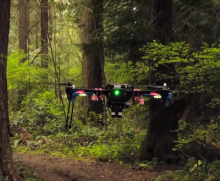 06/16/2017
06/16/2017 TheDrive.com reports that Nvidia is experimenting with navigation technology based on artificial intelligence (AI) coupled with GoPro cameras in a package that provides autonomous flight capability for drones that is not GPS based. GoPro cameras feed visual information to Nvidia’s Jetson TX1 machine learning module. That module learns about and maps the environment.
 06/15/2017
06/15/2017 The latest engines used in the most sophisticated RC aircraft on the planet were out in force at the recent Xponential 2017 national conference, held May 8-11 by the Association for Unmanned Vehicle Systems International (AUVSI) in the Kay Bailey Hutchison Convention Center in Dallas, TX.
The unmanned flying machines these power are used by the military, for traffic control, in support of agriculture and mining, for infrastructure inspection, by cruise ships and in a variety of additional industries. Although electric flight rules in the hobby world, the engines shown here power larger, very sophisticated aircraft that must stay aloft for longer periods.
